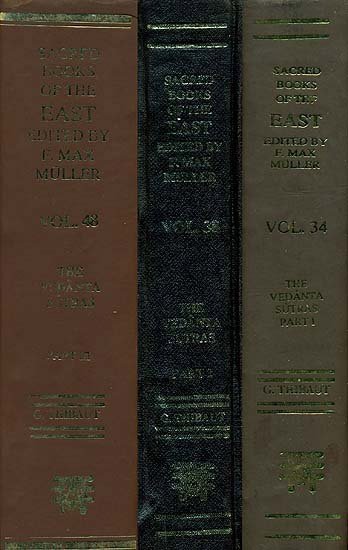Brahma Sutras (Ramanuja)
by George Thibaut | 1904 | 275,953 words | ISBN-10: 8120801350 | ISBN-13: 9788120801356
The English translation of the Brahma Sutras (also, Vedanta Sutras) with commentary by Ramanuja (known as the Sri Bhasya). The Brahmasutra expounds the essential philosophy of the Upanishads which, primarily revolving around the knowledge of Brahman and Atman, represents the foundation of Vedanta. Ramanjua’s interpretation of these sutras from a V...
Sutra 1.1.26
26. If it be objected that (Brahman is) not (denoted) on account of the metre being denoted; (we reply) not so, because thus the direction of the mind (on Brahman) is declared; for thus it is seen.
The previous section at first refers to the metre called Gāyatrī, 'The Gāyatrī indeed is everything' (III, 12, 1), and then introduces—with the words 'this is also declared by a Ṛik verse'—the verse, 'Such is the greatness of it (viz. the Gāyatrī),' etc. Now, as this verse also refers to the metre, there is not any reference to the highest Person.—To this objection the second part of the Sūtra replies. The word 'Gāyatrī' does not here denote the metre only, since this cannot possibly be the Self of all; but the text declares the application of the idea of Gāyatrī to Brahman, i.e. teaches, to the end of a certain result being obtained, meditation on Brahman in so far as similar to Gāyatrī. For Brahman having four feet, in the sense indicated by the ṛik, may be compared to the Gāyatrī with its four (metrical) feet. The Gāyatrī (indeed has as a rule three feet, but) occasionally a Gāyatrī with four feet is met with; so, e.g., 'Indraśśacīpatiḥ | valena pīḍitaḥ | duskyavano vṛshā | samitsu sāsahiḥ.' We see that in other passages also words primarily denoting metres are employed in other senses; thus, e.g., in the saṃvargavidyā (Ch. Up. IV, 3, 8), where Virāj (the name of a metre of ten syllables) denotes a group of ten divine beings.
For this conclusion the next Sūtra supplies a further argument.
